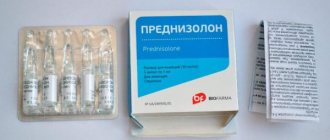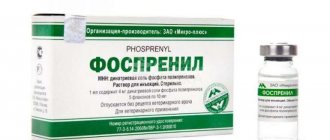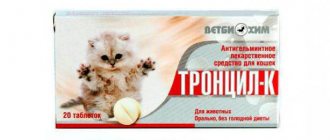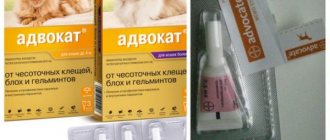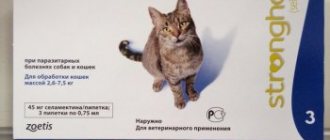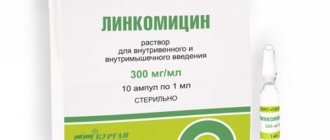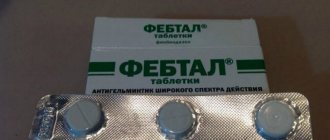general description
The antispasmodic is produced in several dosage forms:
- Injection
. The transparent liquid is packaged in sealed glass ampoules. Some manufacturers use bottles with a plastic cap. They are considered more convenient to use, since there is no risk of injury from glass when opening. 1 ml of solution usually contains 20 mg of papaverine hydrochloride. The composition also includes purified water and other components. - Pills
. Round white tablets are packaged in contour cells of 10 pieces. In pharmacies they come in two dosages - one tablet may contain 10 or 40 mg of the active substance. In addition, the composition includes potato starch, talc, stearic acid and other components that perform exclusively an auxiliary function. - Rectal suppositories
. Small candles are packaged in PVC plates. The concentration of the active substance in them is 20 mg. Excipients are solid fat, emulsifier and cosmetic stearin.
For cats, Papaverine is most often used in injections. The solution is quick-acting, but the tablets are less effective. The active substance included in their composition “works” on the body only half (bioavailability is only 54%). Candles for animals are used in rare cases.
Cost and analogues
What to do if a cat does not tolerate Papaverine well and has contraindications for use? In this case, veterinarians recommend medications with a similar effect. Most often prescribed are Drotaverine, No-Shpa, Spasmol, Spasmonet. All these medications contain the active ingredient drotaverine hydrochloride, a myotropic antispasmodic. In terms of pharmacological properties, it is similar to Papaverine, but acts faster and more effectively.
A significant advantage of Papaverine is its price. In pharmacies, a package of tablets can cost from 15 rubles, and a set of ampoules (10 pcs.) – from 50 rubles. This remedy is available to anyone, it is sold in every pharmacy and is available without a prescription.
How it works
The medication has an antispasmodic effect, that is, the ability to eliminate spasms. The drug also relieves pain that accompanies spasms and lowers blood pressure. The effect of the drug is due to the fact that the active substance blocks the synthesis of enzymes, as a result of which the tone of the smooth muscles that make up the stomach, bladder, kidneys and other internal organs decreases.
When smooth muscle tone is greatly increased, a spasm occurs, which is usually accompanied by acute pain. Under the influence of Papaverine, the muscles of the internal organs relax and tone decreases. The medicine also helps to dilate blood vessels, thereby achieving a hypotensive effect (lowering blood pressure). The drug also has a calming effect on the central nervous system. In this regard, when using Papaverine, animals become calmer and stop showing anxiety.
Note! The drug can affect cardiac activity, so using it on pets without a veterinarian’s prescription is strictly prohibited.
Purpose of the drug
Papaverine is used in cats to relax the smooth muscle layer of the walls of hollow organs (gall bladder and others) and body ducts (ureters, urethra, etc.), which promotes their expansion. Also, smooth muscle fibers are contained in seal vessels such as arteries and arterioles, which also relax under the influence of papaverine. This reduces spasm and pain in the organ, as well as improves its blood supply . Therefore, papaverine is effective for diseases of cats such as cholecystitis, cholangitis, urolithiasis, papillitis, cholecystolithiasis and other similar pathological conditions.
When is it appointed?
The instructions for use for the drug are written for people, but Papaverine is used for cats for similar problems. It is usually prescribed:
- for intestinal colic caused by infections and other factors;
- with pathologies of the digestive system accompanied by acute pain;
- for infectious diseases of the genitourinary system;
- for cystitis caused by hypothermia, pathogenic bacteria and other factors;
- with pylorospasm;
- with cholecystitis;
- for bronchospasm, etc.
Also, the medicine is often used for cats and kittens with urolithiasis and urinary retention caused by other factors. The drug is prescribed to eliminate spasms, pain and other similar symptoms. For example, for urolithiasis or cystitis, Papaverine is injected into cats to eliminate urinary retention. Under the influence of the drug, the bladder and ducts relax, so the animal begins to go to the toilet on its own.
In most cases, the antispasmodic is combined with other drugs, the action of which is aimed at eliminating the cause of the pathology, and not the symptoms. A veterinarian should select complex therapy.
Note! Papaverine has a number of contraindications and can cause side effects if used incorrectly. In this regard, its use on animals is allowed only as prescribed by a doctor.
Indications for use of the drug
The drug is widely used for:
- spasms of smooth muscles;
- urinary system infections;
- intestinal colic;
- diseases of the gastrointestinal tract;
- urinary tract spasms;
- cholecystitis;
- pylorospasm;
- to lower blood pressure.
Sometimes it is prescribed to animals that suffer from bronchospasm and spasm of peripheral vessels. The medicine can solve a number of problems that arise during illnesses. It helps relax the muscles and walls of the bladder, uterus, bronchi and many other organs.
Sometimes an injection of “Papaverine” is administered before any surgical intervention or urological manipulation, as well as to relieve acute pain during the treatment of urolithiasis.
The advantage of using this drug is the painlessness of injections and the rapid distribution of the active substance in the tissues, which helps to quickly relieve pain. The injection is not painful and does not cause anxiety or discomfort in the cat.
How to use
The dosage of the drug is calculated depending on the weight of the animal. Regardless of whether tablets or injections are used, 1-2 mg of the active substance is needed for every kilogram of the pet’s weight, but the doctor must calculate the exact dose, taking into account the severity of the disease and other factors. The medicine is taken 1-2 times a day. The duration of treatment is determined by the doctor depending on the general state of health, the characteristics of the disease, etc.
Important! The course of use of the antispasmodic should not exceed 7 days. Only in rare cases and under strict medical supervision is longer use allowed.
Injections
Papaverine is usually injected subcutaneously into cats. To do this, you need to pull back the fold of skin at the withers, pierce it with a sterile needle on a syringe and slowly inject the medicine. The injection is easy to administer, which is why most pet owners do it. It is better to use an insulin syringe for the injection. It is equipped with a thin needle, which will make it easier to pierce the thick skin on the cat's withers.
Intramuscular administration of the drug is also allowed. With this method, injections can be painful, since discomfort occurs when the needle or solution hits a nerve fiber. In the absence of appropriate skills, this problem is common.
Tablets and suppositories
The tablets can be hidden in food, but they have a bitter taste, so cats often spit them out. In this regard, it is best to give the drug forcibly. To do this, the tablets need to be placed on the root of the tongue, keeping the pet's head elevated. Usually the medicine in this form is given both in the morning and in the evening.
Suppositories are inserted into the anus according to the instructions for use, but this dosage form is used extremely rarely for animals.
Is it possible to give cats No-shpa?
From the introduction it is clear that you can give No-Shpu to a cat. However, the drug is considered potent and, if used incorrectly, causes dangerous side effects. The active ingredient of No-Shpa is drotaverine. The pharmaceutical industry produces an injectable and oral drug under this name.
An alternative drug is papaverine. It also relieves smooth muscle spasm. However, drotaverine has a longer antispasmodic effect.
The issue of using No-Shpa should not be approached lightly. The drug is considered potent, so an overdose leads to dire consequences. Pet owners complain that after the injection, cats develop lameness, and in the worst case, paralysis of the hind limbs.
This may be due to inept administration of the drug. No-Shpu needs to be injected as deep into the muscle as possible. The injection is given slowly to minimize the pain response that causes lameness.
Since the walls of blood vessels are lined with smooth muscle, the lumen increases and the pressure drops.
No-Shpa tablets are very bitter, the cat tries to spit them out, and profuse reflex salivation develops. Therefore, it is wise to place the pill inside the tasty morsel.
Contraindications
Tablets and other dosage forms of Papaverine cannot be used to treat cats in the following cases:
- for glaucoma;
- with liver failure;
- in case of dysfunction of the adrenal glands;
- in a state of shock;
- under severe stress;
- for brain injuries;
- with renal failure.
The medicine should be used with caution if you have tachycardia or other heart problems, as well as with low blood pressure. In this case, the animal must be under the supervision of a veterinarian throughout the entire treatment. The medicine is also contraindicated in case of individual intolerance.
Important! The medicine should not be used on kittens under 6 months of age.
Possible side effects
The antispasmodic can cause the following side effects in cats:
- nausea and vomiting (when using tablets, increased salivation may also occur);
- drowsiness and lethargy;
- heavy sweating;
- lowering blood pressure;
- heart rhythm disturbances;
- constipation
Since the medication affects the central nervous system, temporary loss of hearing or vision and decreased concentration may occur. The risk of side effects increases when the dose is exceeded, so consultation with a doctor before use is required.
Owner reviews
Nina, owner of a 3-year-old cat:
“When our cat Timofey grew up, he had to be neutered, since there are two other cats living in the house. After a while, he was diagnosed with urolithiasis and treated, quite effectively. A couple of months later, an attack occurred - the cat could not go to the toilet, and when it did, there was blood in the urine. I had to go to the clinic again. The doctor prescribed Papaverine and other medications. After just a couple of days the cat felt much better. Problems with urination are now a thing of the past.”
Dmitry, owner of a Persian cat:
“My cat never goes outside; at most she can walk on the windowsill. Despite this, I contracted cystitis somewhere. I noticed that it sits in the tray for a long time, and only a couple of drops come out. The first time they drained urine using a catheter, then they started injecting Papaverine. The cat felt better and began to urinate on its own. The drug is cheap and effective.”
"Papaverine" for cats: dosage, instructions for use, overdose, how to give, reviews
ontakte Odnoklasniki Mail.ru Pinterest
Pets may suffer from pain, and owners are not always able to determine in time the reasons for the pet’s atypical behavior. Sometimes medicine must be given intuitively in an attempt to relieve the suffering of a smaller member of one's family.
“Papaverine” is a drug that, in the correct dosage, will not harm and will quickly help relieve pain.
Chemical composition and characteristics
The active ingredient of the drug is papaverine hydrochloride - an alkaloid of opium poppy (papaver in Latin "poppy"). Depending on the form of production, it may contain solid fat (in suppositories), water for injection, methianine, disodium editate (in ampoules).
Description of the drug
For animals, “Papaverine” is available in the following dosage forms:
- injection;
- pills;
- rectal suppositories.
Solution
For injection, the medicine is available in the form of a 2% solution in packages of 10 ampoules of 2 ml with 40 mg of active substance. Depending on the dose administered to the animal, the amount of liquid can be divided into two injections.
Pills
In the form of tablets, the drug is produced in various packaging - paper, foil and blisters. The usual form of release is a tape or blister containing ten 40 mg tablets.
Important! Despite the simplicity and effectiveness of use, before using the medicine, you should consult a veterinarian.
Rectal suppositories
The most effective and fast-acting type of medication is considered to be rectal suppositories, which are inserted into the pet’s rectum, where they quickly dissolve and are absorbed. Blisters with ten suppositories of 20 mg are available.
https://www.youtube.com/watch?v=lbvTgFhpJ4k
Self-administration of the drug, as well as unauthorized changes in the dose, can lead to extremely undesirable side effects and even the death of your pet.
Biological properties of the drug
The drug causes the synthesis of phosphodiesterase, which helps reduce the concentration of calcium ions in muscle tissue, which contribute to painful contraction. In this way, the muscles can relax and are not caused by extremely painful contractions.
A spasm can block the activity of any internal organ, which may result in a reaction in the form of bleeding, pain, or anxiety. As pain decreases, blood circulation improves and the cat receives long-awaited relaxation.
Find out also how to use the drug "Drotaverine" for a cat.
For intestinal colic
After eating heavy food, pain in the stomach or intestines may occur, due to which the animal cannot find a place for itself and attracts the owner’s attention by meowing. In this case, you can help your pet by giving him orally a Papaverine tablet, which will relax the smooth muscles of the intestines and relieve spasms .
Papaverine copes well with pain and spasms of smooth muscle fibers in cats, but is an extremely dangerous drug
For pathologies of the digestive system
Problems of the digestive system can be solved with the help of suppositories, which will most quickly provide relief from painful symptoms . In this case, the animal will have to either be held tightly or the introduction done quickly. Disorder of the gastrointestinal tract requires quick intervention, which can be provided by rectal suppositories.
Important! You can also use rectal suppositories for further treatment, so as not to frighten the cat and not cause her a painful shock from the injection.
For infectious diseases of the genitourinary system
Infections due to urinary retention or other diseases of the genitourinary system are treated with radical intervention, when it is impossible to hesitate, and the pet’s health and life are at risk. In such cases, “Papaverine” is used in injections. The injection is made at the withers, and to make it, the animal is taken by the scruff of the neck and held firmly until the end of the drug administration.
For cystitis
If your pet meows pitifully when visiting the litter box, it may have cystitis. This disease often manifests itself in adult animals and is accompanied by difficulty urinating and pain. Here, too, the fastest and most effective method is injection under the withers.
We recommend reading about the drug “Stop Cystitis” for cats.
With pylorospasm
Sphincter spasm is not the most common disease in cats, but it does happen sometimes. Obviously, it is necessary to relieve symptoms of pain locally, using rectal suppositories. They must be inserted very carefully and the pet must be held for a while so that the candles do not fall out when moving.
In addition to suppositories, you can add tablets to food, because suppositories can leak when the inflamed sphincter contracts.
For cholecystitis
Cholecystitis is treated with the complex use of medications. “No-shpa”, “Papaverine” or its analogues are injected. All this is introduced to quickly relieve pain from spasms that can debilitate your pet. In the future, when the spasms disappear, you can begin targeted therapy for urolithiasis and gallstone diseases.
